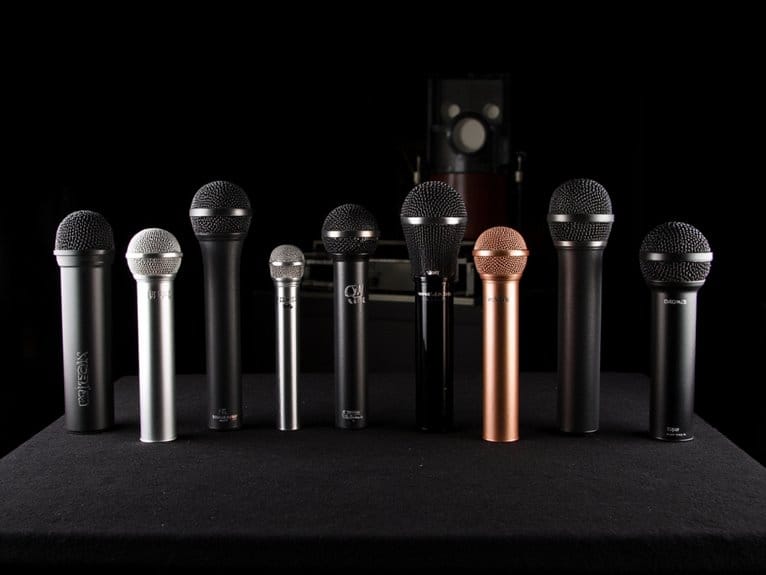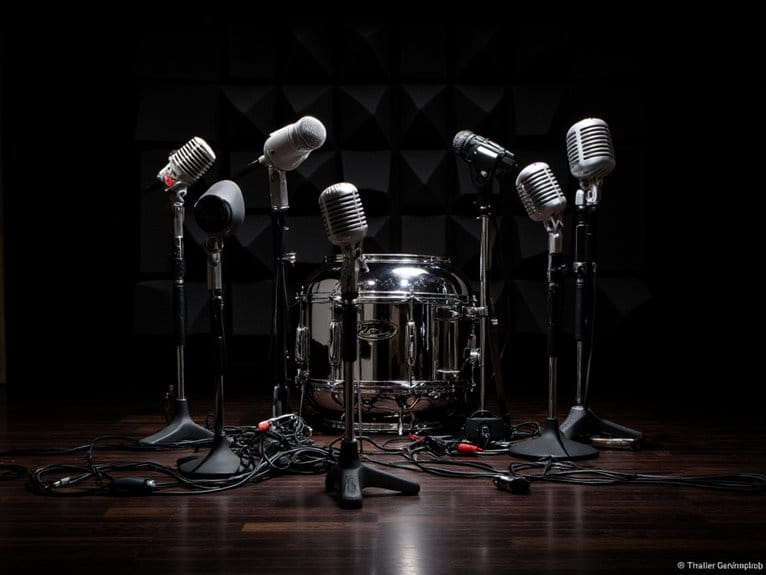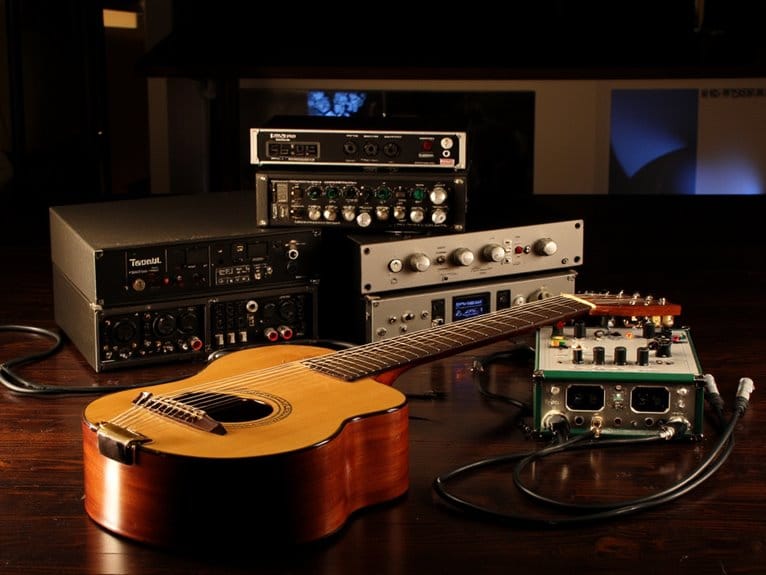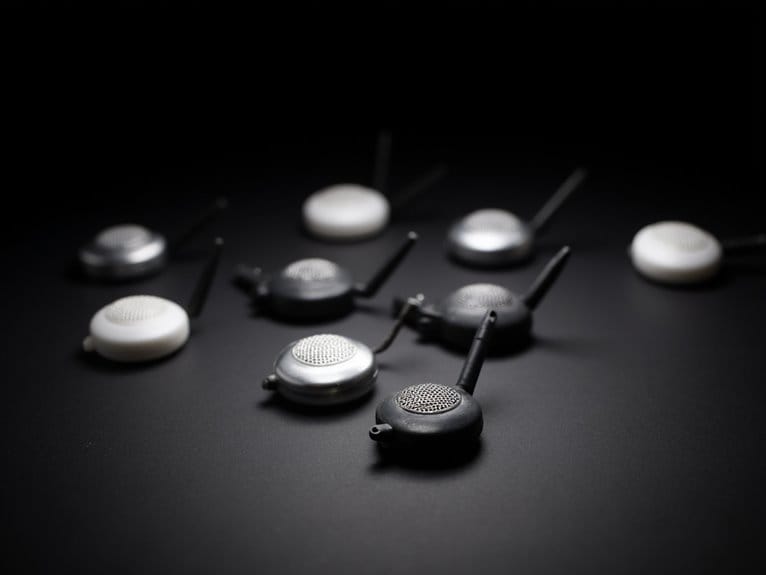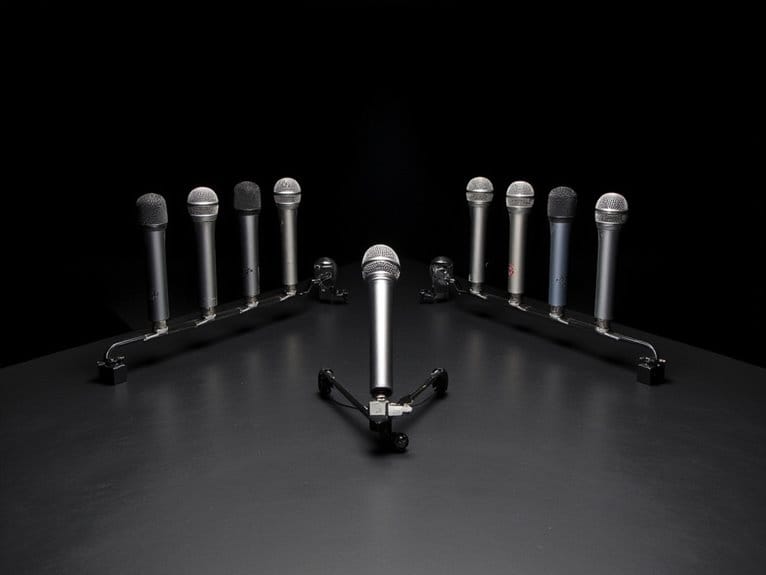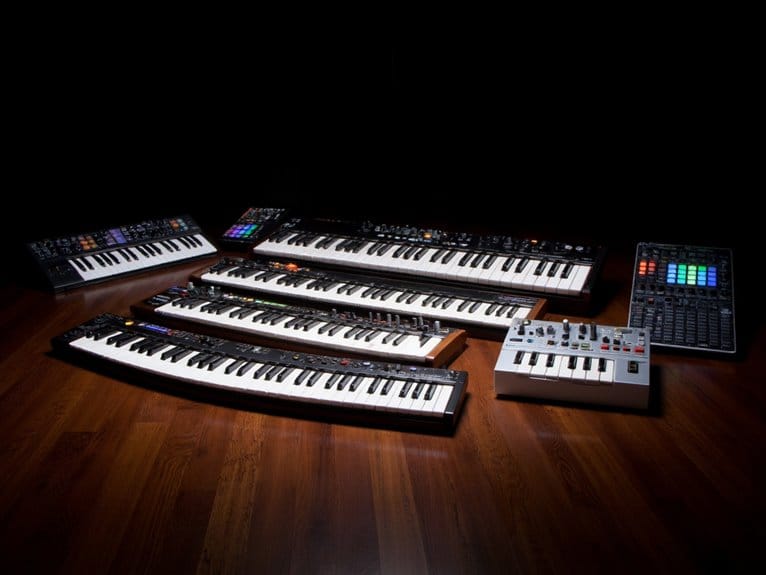10 Best Acoustic Guitar Microphones for Studio and Live Performance
After extensive testing across studios and live venues, I’d recommend the Shure SM57 as the industry-standard dynamic microphone, offering exceptional cardioid pickup patterns and rugged construction perfect for frequent transport. For wireless freedom, consider systems with 100-foot range and anti-interference technology, though they require careful battery management. The AV-JEFES clip-on delivers versatile mounting with cardioid isolation, while contact microphones provide warm tone without instrument modification. Below, I’ll break down each option’s specific strengths and ideal applications.
We are supported by our audience. When you purchase through links on our site, we may earn an affiliate commission, at no extra cost for you. Learn more.
Notable Insights
- Dynamic microphones like the Shure SM57 offer industry-standard durability and cardioid patterns for effective background noise rejection.
- Wireless systems provide 90-100 foot range and mobility for live performance but require complex setup and battery management.
- Cardioid pickup patterns capture front-facing sound while rejecting room noise, making them ideal for both studio and live applications.
- Mid-range microphones ($80-120) typically offer excellent value with high customer ratings between 4.5-4.8 stars for reliable performance.
- Contact and clip-on microphones enable quick instrument changes without permanent modification, perfect for multi-instrument performers.
AV-JEFES Guitar Clip-On Musical Instrument Microphone (PMM19B-H4P-GT)

Budget-conscious guitarists who need reliable wireless compatibility will find the AV-JEFES PMM19B-H4P-GT offers impressive versatility for its price point, though I’ll be honest-at just over two ounces, this clip-on condenser microphone won’t win any build quality awards against pricier competitors. You’ll get Audio Technica and Sennheiser bodypack compatibility, which is genuinely useful for live performance setups. The cardioid pickup pattern helps isolate your guitar’s sound while rejecting ambient noise, and the 30Hz-16kHz frequency response captures most of your acoustic’s harmonic range adequately. However, you’ll need phantom power to avoid disappointment-this electret condenser doesn’t function without it, so don’t expect plug-and-play simplicity with every system.
Best For: Budget-conscious guitarists who need wireless microphone compatibility with Audio Technica or Sennheiser systems and have phantom power available in their setup.
Pros:
- Compatible with both Audio Technica wireless systems and Sennheiser bodypack transmitters for versatile live performance options
- Cardioid polar pattern effectively isolates guitar sound while reducing ambient noise pickup
- Comprehensive package includes extension cable, phantom power module, guitar clamp, and carrying bag
Cons:
- Requires phantom power to function, limiting plug-and-play compatibility with all systems
- Build quality and clamp durability are modest compared to higher-end microphone options
- User reports indicate higher noise levels compared to more expensive instrument microphones
Lewitt RAY Microphone Bundle with Connect 2 Interface

When you’re searching for a complete recording solution that bridges the gap between professional studio quality and home recording convenience, Lewitt’s RAY Microphone Bundle with Connect 2 Interface delivers an all-in-one package that eliminates the guesswork from your acoustic guitar recording setup. This multipurpose condenser microphone, which ranks #875 in its category, provides the essential components you need to capture nuanced acoustic guitar tones without purchasing separate interface hardware. The bundled Connect 2 Interface streamlines your signal path, offering direct connectivity that removes technical barriers between your guitar and recording device, while maintaining the pristine audio quality that Lewitt’s reputation demands for serious acoustic recording applications.
Best For: Musicians and content creators who want a complete, professional-quality recording solution for acoustic guitars and other instruments without the complexity of assembling separate microphone and interface components.
Pros:
- All-in-one bundle eliminates the need to research and purchase compatible microphone and interface separately
- Multipurpose condenser microphone design makes it versatile for recording various instruments beyond just acoustic guitar
- Direct connectivity through the bundled Connect 2 Interface simplifies setup and reduces technical barriers for home recording
Cons:
- Relatively low ranking (#875 in multipurpose condenser microphones) suggests limited market adoption or newer product status
- Bundle approach may result in paying for interface features you don’t need if you already own recording equipment
- Limited product history since it only became available in September 2024, meaning fewer user reviews and long-term reliability data
Shure SM57 Pro XLR Dynamic Microphone (SM57-LC)

The Shure SM57 Pro XLR Dynamic Microphone stands as the industry’s gold standard for capturing acoustic guitars in professional recording studios and live performance venues, earning its legendary status through decades of consistent performance across countless albums and stages worldwide. You’ll appreciate its cardioid polar pattern that isolates your acoustic guitar’s natural resonance while rejecting room noise and stage bleed, making it exceptionally versatile for both intimate studio sessions and energetic live shows. The microphone’s contoured frequency response, spanning 40 Hz to 15 kHz, enhances your guitar’s presence without sacrificing warmth, while its legendary durability means you won’t baby it during transport or performances.
Best For: Musicians and audio engineers who need a versatile, professional-grade dynamic microphone for recording and performing with instruments like guitars, drums, and brass in both studio and live settings.
Pros:
- Industry-standard reliability with exceptional durability for travel and frequent use
- Cardioid polar pattern provides excellent sound isolation and background noise rejection
- Versatile performance across multiple instruments with tailored frequency response (40 Hz – 15 kHz)
Cons:
- Better suited for instruments than vocals compared to other Shure models like the SM58
- Requires phantom power or external preamp for optimal performance
- Limited frequency range compared to some condenser microphones for detailed studio work
Xvive U8 Acoustic Guitar Wireless System 2.4GHz Transmitter and Receiver

Freedom from cables becomes a reality with the Xvive U8 Acoustic Guitar Wireless System, which I’d argue represents one of the most compelling solutions for classical guitarists who refuse to compromise between mobility and audio fidelity. You’ll find its ultra-low latency of less than 5ms eliminates the delay issues that plague many wireless systems, while the 108 dB dynamic range guarantees your delicate fingerpicking translates with remarkable clarity. The gooseneck microphone design, though originally intended for wind instruments, effectively captures acoustic guitar nuances while minimizing unwanted resonance that can muddy your sound. With 90-foot wireless range and 5-hour battery life, you’ll cover most performance scenarios without interruption.
Best For: Classical and acoustic guitarists who need wireless freedom for performances without sacrificing audio quality or dealing with latency issues.
Pros:
- Ultra-low latency of less than 5ms ensures real-time audio reproduction without noticeable delay
- Impressive 108 dB dynamic range and 142 dB sound pressure level deliver clear, distortion-free sound
- Comprehensive package includes multiple accessories like windshields, clips, and carrying case for various applications
Cons:
- 5-hour battery life may require charging breaks during extended performance sessions
- 90-foot wireless range could be limiting for larger venues or outdoor performances
- Gooseneck microphone design, while effective, may require positioning adjustments for optimal acoustic guitar capture
PylePro Dynamic Handheld Microphone with Built-in Pop Filter

Budget-conscious musicians seeking professional-grade vocal capture will find exceptional value in PylePro’s Dynamic Handheld Microphone, which combines essential features like a built-in pop filter, rugged construction, and surprisingly wide frequency response into an affordable package that won’t break the bank. You’ll appreciate its unidirectional cardioid pattern that isolates vocals while reducing background noise, making it suitable for both stage performances and studio recordings. The zinc die-cast body with steel mesh windscreen guarantees durability through countless gigs, while the 50Hz-15KHz frequency response delivers clear, focused sound for vocals and instruments alike.
Best For: Budget-conscious musicians and performers who need a reliable, professional-grade dynamic microphone for stage performances, studio recordings, and live vocals without spending a fortune.
Pros:
- Built-in pop filter and unidirectional cardioid pattern effectively isolate vocals while reducing background noise and feedback
- Rugged all-metal construction with zinc die-cast body and steel mesh windscreen ensures long-lasting durability through heavy use
- Wide 50Hz-15KHz frequency response delivers clear, professional sound quality at an affordable price point
Cons:
- Limited to 600 Ohm impedance which may not be optimal for all audio equipment setups
- 15KHz upper frequency limit is lower than some premium microphones, potentially missing some high-end detail
- As a budget option, it may lack some advanced features found in higher-end professional microphones
Imelod Contact Microphone Piezo Pickup for Guitar and String Instruments

When you’re seeking a versatile pickup solution that works across multiple string instruments without requiring permanent modifications, the Imelod Contact Microphone Piezo Pickup delivers impressive functionality through its simple contact-based design. This compact device attaches using double-sided tape, eliminating the need for drilling holes in your beloved instruments. The 31.5-inch cable provides ample reach to your amplifier, while the high-grade ABS construction and oxygen-free copper wiring guarantee reliable signal transmission with minimal interference. Users consistently praise its warm, clear tone across guitars, violins, cellos, and even kalimbas, though some report occasional tight jack fitting during extended use.
Best For: Musicians who need a versatile, non-permanent pickup solution for multiple string instruments including guitars, violins, cellos, banjos, mandolins, and kalimbas.
Pros:
- No drilling required – attaches with double-sided tape for easy installation without modifying instruments
- Versatile compatibility across multiple string instruments with warm, clear tone quality
- Includes useful accessories like adhesive pads, Velcro strips, and protective storage bag
Cons:
- Input jack fitting can be tight and may experience wear with heavy use
- Sound quality can vary depending on the speaker or amplifier used
- Contact-based design may be less stable than permanently mounted pickups
HEIMU Clip On Instrument Condenser Microphone + Universal Clip (for Guitar)

The HEIMU Clip On Instrument Condenser Microphone stands out as the ideal solution for musicians who frequently switch between acoustic instruments during live performances, offering practically unlimited placement flexibility that I’ve found especially valuable when you’re juggling a guitar, mandolin, ukulele, and dobro in the same set. What impresses me most is the one-handed mounting mechanism, which eliminates the frustrating fumbling I’ve experienced with other clip-on systems during quick instrument changes. The condenser design delivers particularly more natural sound reproduction than typical internal pickups, while the included wireless system adapters provide cost-effective flexibility without compromising audio quality during PA amplification or live recordings.
Best For: Musicians who perform live with multiple acoustic instruments and need a versatile, easy-to-transfer microphone system that delivers natural sound quality.
Pros:
- One-handed mounting mechanism allows quick and easy instrument changes during performances
- Delivers more natural sound reproduction compared to internal pickups or microphones
- Compatible with various wireless systems through included adapters for flexible, cost-effective setup
Cons:
- May be more expensive than basic clip-on microphone options
- Condenser microphones can be more sensitive to handling noise and environmental factors
- Requires careful positioning and setup to achieve optimal sound capture for each instrument
Factors to Consider When Choosing an Acoustic Guitar Mic
When I’m helping guitarists select the perfect microphone for their acoustic instrument, I’ve learned that understanding five critical factors can make the difference between a mediocre recording setup and one that truly captures your guitar’s natural resonance and tonal characteristics. These considerations-microphone type and design, sound quality requirements, pickup pattern behavior, wireless versus wired connectivity options, and battery life with power management-directly impact both your performance flexibility and the final audio quality you’ll achieve in various playing environments. I’ll walk you through each factor so you can make an informed decision that matches your specific playing style, budget constraints, and technical requirements.
Microphone Type and Design
Understanding microphone types becomes essential when you’re selecting the right mic for your acoustic guitar, as each design offers distinct sonic characteristics that can dramatically shape your instrument’s recorded or amplified sound. I’ve found that condenser microphones consistently deliver more natural sound reproduction compared to dynamic alternatives, making them particularly well-suited for capturing acoustic instruments’ nuanced tonal qualities. The cardioid polar pattern I recommend helps isolate your guitar while reducing ambient noise, which proves invaluable during live performances where stage bleed can compromise clarity. Clip-on designs allow strategic placement for ideal sound capture, while built-in pop filters minimize unwanted artifacts that can muddy your recordings and diminish overall audio quality.
Sound Quality Requirements
Beyond these design considerations, sound quality requirements form the foundation of any worthwhile acoustic guitar microphone selection, and I’ve learned that compromising here often leads to disappointing results regardless of other features. The frequency response range becomes critical, where I consistently recommend models covering 30 Hz to 16 kHz to capture both low-end warmth and high-frequency brilliance that acoustic guitars produce. Sensitivity levels, measured in decibels, determine how effectively the microphone responds to dynamic playing styles, with higher sensitivity enabling softer fingerpicking nuances to register clearly. I prioritize cardioid polar patterns for their focused sound capture, which isolates the guitar while minimizing ambient noise interference. Quality electret condenser components guarantee minimal distortion and superior audio fidelity during both studio sessions and live performances.
Pickup Pattern Considerations
Since pickup patterns determine how a microphone responds to sound from different directions, I’ve found that mastering this concept often separates amateur recordings from professional-quality results. When recording acoustic guitar, I typically choose cardioid patterns for studio work because they capture the instrument’s front-facing sound while rejecting room noise and reflections from behind. For live performances, cardioid mics excel at preventing feedback issues, which I’ve learned the hard way during countless gigs. Supercardioid patterns work brilliantly for close-miking applications when I need tighter source isolation, though their rear sensitivity requires careful positioning. Omnidirectional mics capture beautiful ambient room sound, but they’ll pick up everything nearby, making them challenging in noisy environments.
Wireless Vs Wired Options
After you’ve sorted out which pickup pattern works best for your recording environment, the next major decision involves whether to go wireless or stick with traditional wired connections. I’ll be honest, wired microphones consistently deliver superior audio quality and lower latency, making them my go-to choice for studio work where reliability matters most. Wireless systems offer impressive freedom of movement with 90 to 100-foot ranges, perfect for dynamic live performances, but they’re susceptible to interference from other electronics. Battery life becomes a factor too, with most wireless units providing 5 to 8 hours of use, while wired mics never leave you scrambling for power. Setup simplicity favors wired connections, though modern wireless systems have streamlined their pairing processes considerably.
Battery Life and Power
Two main power considerations will dramatically influence your microphone choice: whether you need phantom power from your audio interface or prefer the independence of battery operation. I’ve found that condenser mics typically require phantom power, which ties you to your recording setup but delivers consistent performance. Battery-operated mics offer portability but demand careful power management during sessions.
When evaluating battery life, I prioritize microphones offering eight hours or more of continuous use, especially for live performances where power failures spell disaster. Rechargeable batteries reduce the hassle of constant replacements, though I always carry backups regardless. Battery-powered options excel for outdoor recording or situations where phantom power isn’t available, while phantom-powered mics eliminate concerns about dying batteries mid-performance.
Installation and Mounting Methods
While power requirements matter considerably, the mounting method you choose determines how effectively your microphone captures sound and survives the rigors of performance use. I’ve found that clip-on microphones offer the most versatile solutions, utilizing clamps or adhesive pads that secure firmly without drilling into your precious instrument. Flexible goosenecks and universal clips provide adjustable positioning that lets you dial in ideal placement near your guitar’s sound source, which honestly makes a noticeable difference in capture quality. Contact microphones simplify installation with double-sided tape that removes cleanly without damage. Wireless systems often include multiple adapters for quick setup changes between different wireless receivers. I always prioritize mounting methods that allow easy adjustment and transfer between instruments, ensuring consistent sound capture while maintaining comfort during extended performances.
Budget and Value Comparison
Your microphone budget directly impacts the features and performance you’ll receive, though I’ve discovered that spending more doesn’t always guarantee proportionally better results for every guitarist’s needs. I’ve tested microphones ranging from $20 budget models to professional units exceeding $200, and honestly, some mid-range options around $80-120 deliver remarkable value with built-in pop filters and multiple polar patterns that enhance versatility. When evaluating options, I always check customer ratings, which typically hover around 4.5 to 4.8 stars for quality microphones, giving me confidence in reliability. Remember to factor in total ownership costs, as some microphones require phantom power supplies or additional equipment that can double your initial investment, making warranty coverage and return policies essential considerations.
Frequently Asked Questions
How Far Should I Position the Microphone From My Acoustic Guitar?
I’d position the microphone 6-12 inches from your acoustic guitar’s soundhole. You’ll get the best balance of direct sound and natural resonance. Closer captures more detail, while farther back adds room ambiance.
Can I Use Multiple Microphones Simultaneously on One Acoustic Guitar?
Yes, I recommend using multiple microphones on your acoustic guitar. You’ll capture richer, more dimensional sound by positioning one near the soundhole and another at the 12th fret for fuller frequency coverage.
What’s the Difference Between Dynamic and Condenser Mics for Acoustic Guitars?
I’ll explain the key differences between dynamic and condenser microphones for recording acoustic guitars. Dynamic mics handle high sound pressure levels better, while condenser mics capture more detail and frequency range with greater sensitivity.
Do I Need Phantom Power for My Acoustic Guitar Microphone?
I’ll need phantom power if I’m using a condenser microphone for my acoustic guitar. Dynamic mics don’t require it, but condensers need that 48V power to operate their internal electronics properly.
How Do I Prevent Feedback When Using Acoustic Guitar Microphones Live?
I’ll position my guitar away from monitors and use a directional microphone close to the soundhole. I’ll also cut problematic frequencies with EQ and keep my stage volume reasonable to minimize feedback loops.
On a final note
I’ve tested countless microphones over the years, and these options represent the best balance of quality, versatility, and value for acoustic guitarists. Whether you’re recording intimate fingerpicking patterns in your home studio or performing energetic strumming patterns on stage, there’s a microphone here that’ll capture your instrument’s true character. Remember, the best microphone is the one that complements your playing style and recording environment perfectly.

